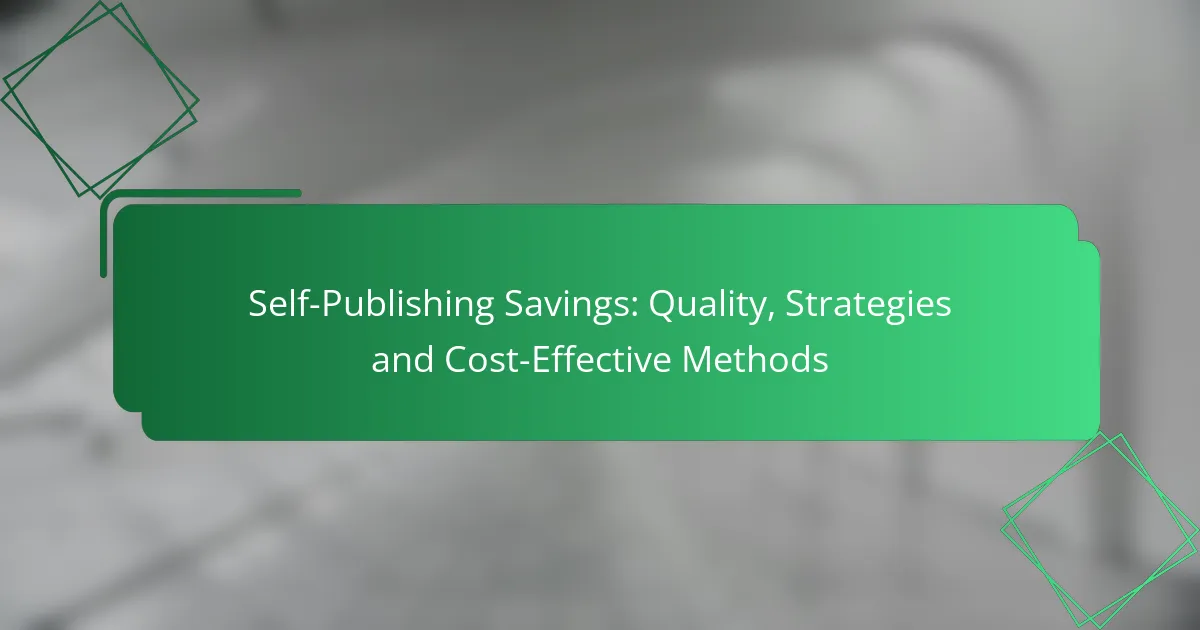Self-publishing offers authors the opportunity to maintain control over their work while ensuring high quality through professional editing, appealing cover design, and strategic marketing. By leveraging free resources and DIY tools, writers can significantly reduce costs without compromising on quality. Embracing digital platforms and social media further enhances visibility and reach, making self-publishing a viable and cost-effective option for aspiring authors.
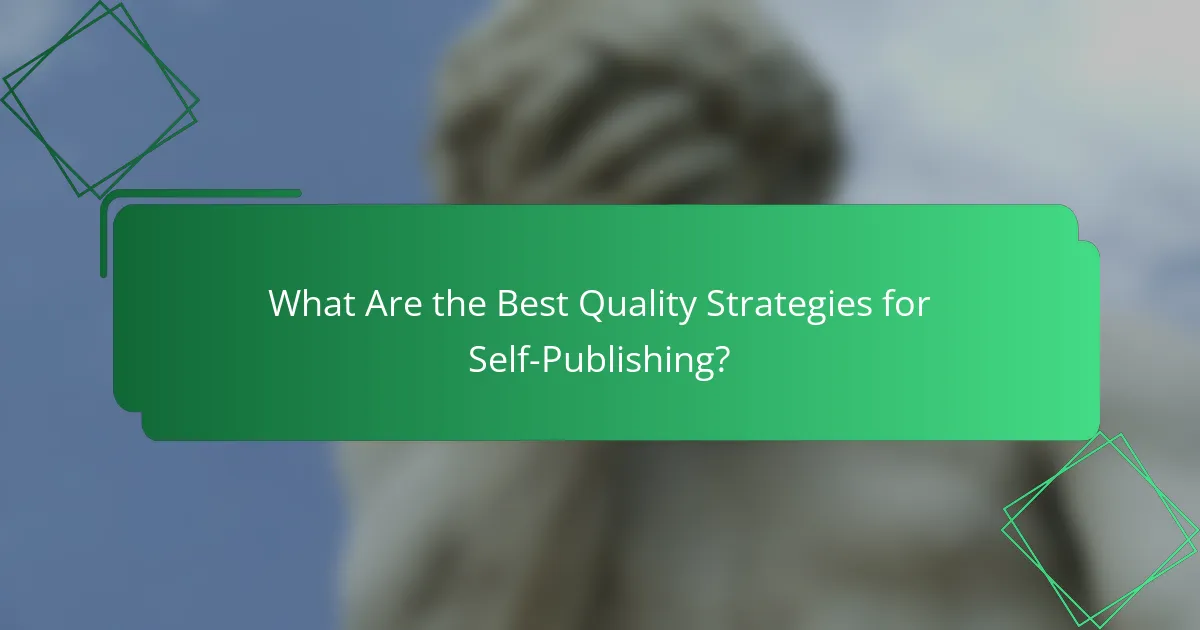
What Are the Best Quality Strategies for Self-Publishing?
To ensure high quality in self-publishing, focus on professional editing, appealing cover design, effective formatting, gathering beta reader feedback, and implementing strategic marketing. These strategies enhance the overall presentation and marketability of your book.
Editing and Proofreading Services
Investing in editing and proofreading is crucial for self-published authors. Professional editors can help refine your manuscript, ensuring clarity, coherence, and grammatical accuracy. Consider hiring a developmental editor for structural feedback and a copyeditor for line-by-line corrections.
Rates for editing services can vary widely, typically ranging from $0.01 to $0.05 per word, depending on the editor’s experience and the level of editing required. Always request samples of previous work to gauge quality before making a commitment.
Professional Cover Design
A professional cover design significantly impacts a book’s marketability. A well-designed cover not only attracts readers but also conveys the genre and tone of your work. Hiring a graphic designer with experience in book covers is advisable.
Cover design costs can range from $100 to over $1,000, depending on the designer’s expertise and the complexity of the design. Ensure the final cover is formatted correctly for both print and digital versions to avoid additional costs later.
Formatting Tools
Proper formatting is essential for both print and eBook versions of your book. Tools like Scrivener, Vellum, or Reedsy can help you format your manuscript to meet industry standards. Each tool offers different features, so choose one that fits your technical comfort level.
For print books, ensure you follow the specific guidelines provided by your chosen publisher or platform, such as Amazon KDP or IngramSpark. This includes margins, font size, and layout, which can affect printing costs and overall presentation.
Beta Reader Feedback
Gathering feedback from beta readers can provide invaluable insights into your manuscript’s strengths and weaknesses. Select a diverse group of readers who represent your target audience to get a well-rounded perspective.
Consider creating a feedback form with specific questions about plot, character development, and pacing to guide your readers. This process can help identify areas that need improvement before final publication.
Marketing Strategies
Effective marketing is essential for the success of your self-published book. Utilize social media platforms, author websites, and email newsletters to build an audience and promote your work. Engaging with potential readers through book trailers, blog tours, and giveaways can also increase visibility.
Consider investing in paid advertising on platforms like Facebook or Amazon, where you can target specific demographics. Setting a marketing budget of around 10-20% of your expected revenue can help you allocate resources effectively while maximizing your book’s reach.
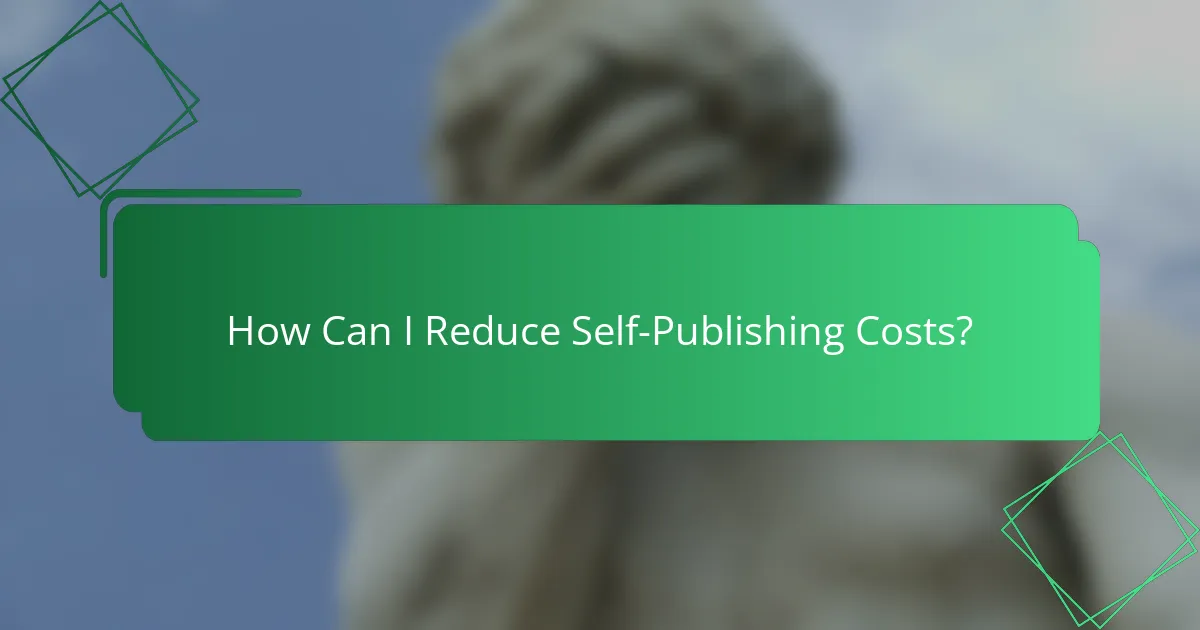
How Can I Reduce Self-Publishing Costs?
Reducing self-publishing costs involves leveraging free resources, DIY tools, and strategic planning. By utilizing available platforms and services, you can significantly cut expenses while maintaining quality.
Utilizing Free Publishing Platforms
Free publishing platforms like Amazon Kindle Direct Publishing, Smashwords, and Wattpad allow authors to publish their work without upfront costs. These platforms often provide essential tools for formatting and distribution, making it easier to reach a wide audience.
When choosing a platform, consider the royalty structures and distribution options. For instance, Kindle Direct Publishing offers up to 70% royalties on eBooks priced between $2.99 and $9.99, which can be a lucrative option for many authors.
DIY Design Tools
Designing your book cover and interior layout can save money. Tools like Canva, Adobe Spark, and GIMP offer user-friendly interfaces for creating professional-looking designs without hiring a graphic designer.
When using DIY design tools, focus on key elements like typography and color schemes that align with your genre. Aim for a clean, eye-catching cover that stands out in online marketplaces, as this can significantly impact sales.
Print-on-Demand Services
Print-on-demand (POD) services like IngramSpark and Lulu enable authors to print copies of their books as orders come in, eliminating the need for large upfront printing costs. This method is particularly beneficial for niche markets or first-time authors who may not have a guaranteed audience.
Consider the pricing models of different POD services. Some may charge setup fees or take a percentage of sales, so it’s essential to compare options to find the most cost-effective solution for your needs.
Budgeting for Marketing
Effective marketing is crucial for self-published authors, but it doesn’t have to be expensive. Allocate a budget for essential marketing activities, such as social media advertising, email marketing, and book promotion services.
Start with a modest budget, perhaps around $100 to $300, and track your spending and results. Focus on low-cost strategies like building an author website, engaging with readers on social media, and utilizing free promotional tools to maximize your reach without overspending.
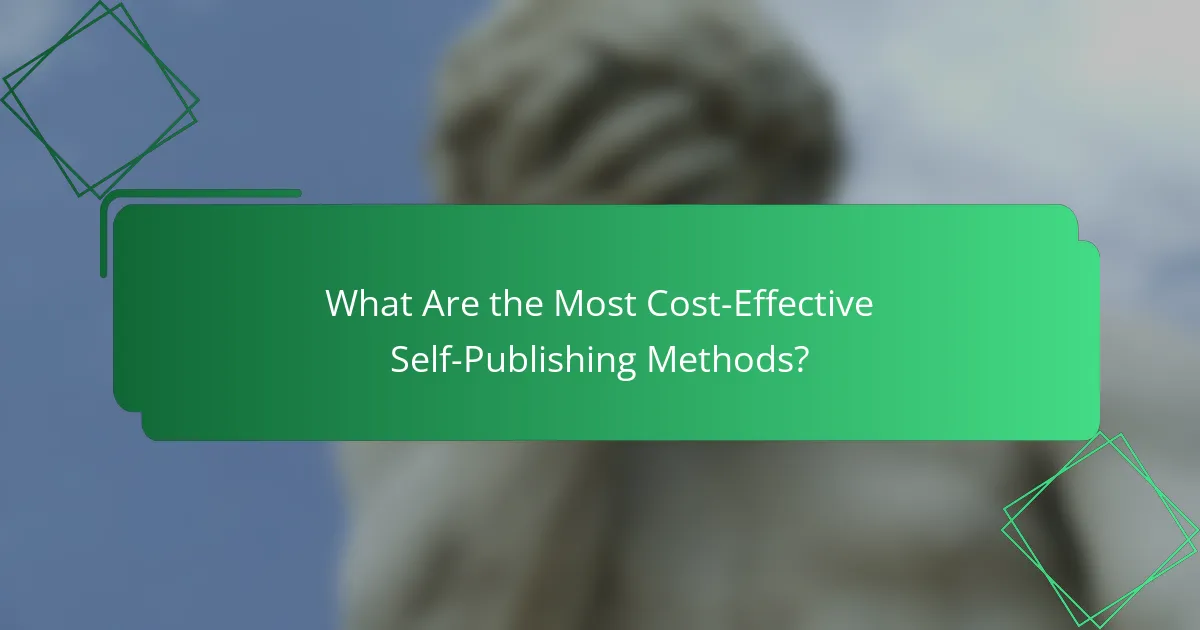
What Are the Most Cost-Effective Self-Publishing Methods?
The most cost-effective self-publishing methods focus on maximizing reach while minimizing expenses. Utilizing digital platforms and leveraging social media can significantly reduce costs while maintaining quality and visibility.
eBook Distribution Options
eBook distribution can be achieved through various platforms, including Amazon Kindle Direct Publishing, Smashwords, and Draft2Digital. These services often charge minimal fees or take a percentage of sales, making them affordable choices for self-publishers.
Consider distributing your eBook across multiple platforms to increase visibility. This strategy can help you reach a broader audience and potentially boost sales, as each platform has its unique user base.
Social Media Promotion
Social media promotion is a powerful tool for self-publishers, allowing you to connect directly with potential readers. Platforms like Facebook, Twitter, and Instagram enable authors to share updates, engage with followers, and promote their work at little to no cost.
To maximize effectiveness, create a content calendar that includes regular posts, promotional campaigns, and interactive content. Engaging with your audience through comments and messages can foster a loyal reader base.
Collaborative Marketing
Collaborative marketing involves partnering with other authors or businesses to promote each other’s work. This method can reduce costs and expand your reach by tapping into each partner’s audience.
Consider joining author groups or local writing communities to find potential collaborators. Co-hosting events, sharing newsletters, or cross-promoting on social media can enhance visibility for all involved while keeping expenses low.
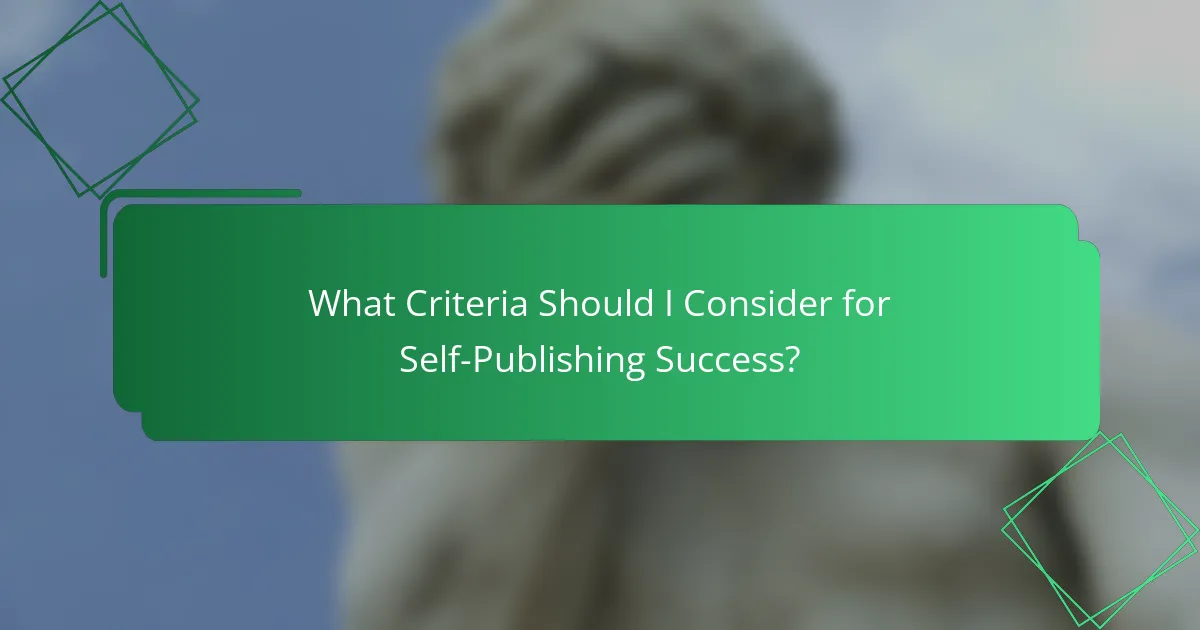
What Criteria Should I Consider for Self-Publishing Success?
To achieve self-publishing success, focus on understanding your target audience, conducting thorough market research, and ensuring high-quality content. These criteria will guide your decisions and increase the likelihood of your book’s acceptance and sales in the market.
Target Audience Identification
Identifying your target audience is crucial for self-publishing. Consider demographics such as age, gender, interests, and reading habits to tailor your content effectively. For instance, a young adult fantasy novel will appeal to a different audience than a business self-help book.
Utilize social media platforms and online forums to engage with potential readers and gather insights. Tools like surveys can help you refine your understanding of what your audience values in a book.
Market Research Techniques
Effective market research involves analyzing existing books in your genre to identify trends and gaps. Look at bestseller lists, read reviews, and assess what readers appreciate or criticize about similar titles. This can inform your writing style and marketing approach.
Consider using keyword research tools to discover what potential readers are searching for online. This data can guide your book’s title, description, and promotional strategies, ensuring they resonate with your audience’s interests.
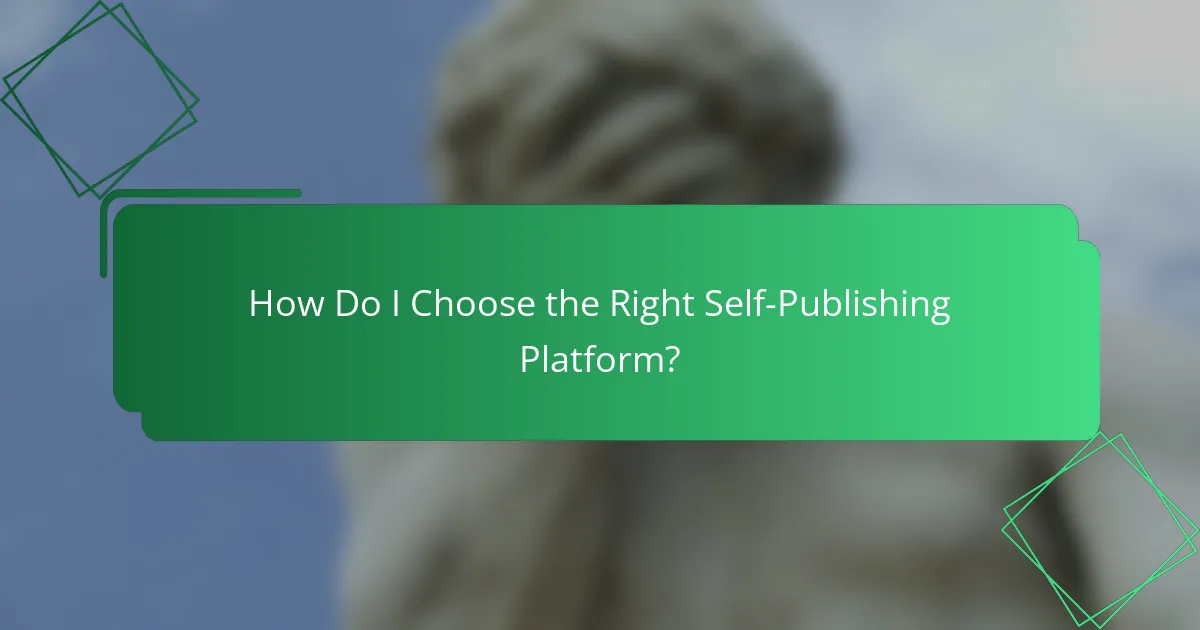
How Do I Choose the Right Self-Publishing Platform?
Choosing the right self-publishing platform involves assessing your specific needs, such as distribution options, ease of use, and potential earnings. Consider factors like the types of content you want to publish and your target audience to find a platform that aligns with your goals.
Comparison of Popular Platforms
Several self-publishing platforms are widely used, including Amazon Kindle Direct Publishing (KDP), IngramSpark, and Smashwords. Each platform has unique features; for instance, KDP offers extensive reach through Amazon, while IngramSpark provides access to a broader range of retailers.
When comparing platforms, look at their formatting requirements, distribution networks, and marketing tools. For example, KDP is user-friendly for beginners, while IngramSpark may require more technical knowledge but offers superior print distribution options.
Platform Fees and Royalties
Understanding platform fees and royalties is crucial for maximizing your earnings. Amazon KDP typically offers royalties of 35% to 70% depending on the price of your book, while IngramSpark charges setup fees and takes a percentage of sales.
Be aware of additional costs, such as printing fees for physical copies or distribution fees for wider reach. Always read the fine print to avoid unexpected charges that could impact your profits.
User Experience and Support
User experience varies significantly across platforms. KDP is known for its intuitive interface, making it easier for new authors to navigate. In contrast, platforms like Smashwords may have a steeper learning curve due to their comprehensive formatting guidelines.
Support options are also important. KDP provides extensive online resources and community forums, while IngramSpark offers customer service but may have longer response times. Consider your comfort level with technology and the type of support you may need when choosing a platform.
